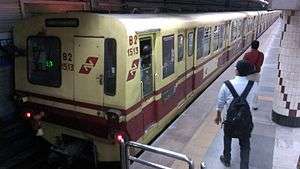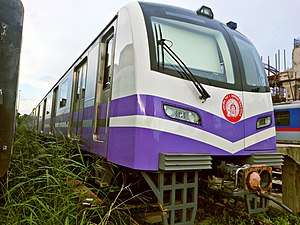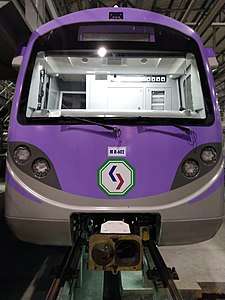Kolkata Metro rolling stock
Since Kolkata Metro was constructed in 1970s, there were some technical limitations. Due to the tunnel dimensions, and being under Indian Railways, Kolkata Metro opted Indian metre gauge shell (22.7m) with 1676 mm Broad Gauge tracks. So the options of rake manufacturers for Kolkata Metro Line 1 is very limited. While, the Kolkata Metro Line 2, being modern, uses the 1435 mm Standard Gauge tracks.
| Part of a series of articles on the |
| Kolkata Metro |
|---|
|
|
|
Line 1
ICF/BHEL rake (1000 series)
9 rakes were manufactured by ICF, Chennai and were passed into service in the first phase when the metro initially ran from Esplanade to Bhawanipur.[2] These trains were dark green in colour and had a yellow stripe at the bottom. Later the colour was changed to white with a dark blue stripe. Presently they are yellow with a wide brown band at the bottom. These rakes are numbed Bn (where n is the rake no.; 1, 2,...., 9)[3]

| Operating from | October 1984 - January 2020[4] |
| Line | 1 |
| Total fleet size | 9 |
| Length per coach | 19.5 m |
| Length per train | 156 m |
| Width per coach | 2.74 m |
| Maximum speed | 55 km/h |
| Average operating speed | 30–31 km/h |
| Voltage | 750 V DC |
| Electrification | 3rd rail |
| Coaches per train | 8 |
| Capacity per coach | 300 approx.[5] |
| Capacity per train | 2400 approx. |
| Total horse power of rake | 3036 HP |
| Rake Composition | 6 MC + 2 TC |
| Environment control | Non AC with forced
ventilation with washed and cooled air |
| Livery |
ICF/NGEF rake (2000 series)
By 1988–90, 9 more rakes manufactured by ICF were put into operation in the next phase of service when the system expanded. These rakes were tougher and had higher acceleration than the previous ones. The colors of these trains were dark yellow with a maroon stripe at the bottom, later they were repainted in white with a maroon stripe and now they are white with a blue band at the bottom. In 2017–18, these were refurbished and put into service in a phased manner. The rakes are marked with 8N symbols.[6]
| Operating from | 1988 – January 2020[7] |
| Line | 1 |
| Total fleet size | 9 |
| Length per coach | 19.5 m |
| Length per train | 156 m |
| Width per coach | 2.74 m |
| Maximum speed | 80 km/h[8] |
| Average operating speed | 30–31 km/h |
| Voltage | 750 V DC |
| Electrification | 3rd rail |
| Coaches per train | 8 |
| Capacity per coach | 300 approx.[5] |
| Capacity per train | 2400 approx. |
| Total horsepower of rake | 5221 HP |
| Rake Composition | 6 MC + 2 TC |
| Environment control | Non AC with forced
ventilation with washed and cooled air |
| Livery | and |
ICF/BHEL/Knorr-Bremse rake (3000 series)
These are the first AC trains that were passed into service in 2010, after the elevated corridor from Mahanayak Uttam Kumar to Kavi Nazrul was completed. Later, as the last extension from Kavi Nazrul to Kavi Subhash was finished, more 3000 series rakes were introduced. These trains are manufactured by ICF in collaboration with BHEL and Knorr-Bremse, Germany. They have microprocessor controlled temperature and humidity, LCD displays inside the motorman's cabins and multilingual electronic LED sign boards both inside and outside the train. Presently there are 13 (3000 series) rakes, which are operating on Line 1. These rakes are numbed ACn/n+1 (where (n+1)/2 is the rake number). The rolling stocks numbers are now being changed to MR-30n (where n is the rake no.; 1, 2, 3....13) as they are being gradually repainted to white and violet.
| Operating from | October 2010 – present |
| Line | 1 |
| Total fleet size | 13 |
| Length per coach | 20.3 m |
| Length per train | 162.4 m |
| Width per coach | 2.74 m |
| Maximum speed | 80 km/h |
| Average operating speed | 35 km/h |
| Voltage | 750 V DC |
| Electrification | 3rd rail |
| Coaches per train | 8 |
| Capacity per coach | 392[5] |
| Capacity per train | 3136 approx. |
| Total horse power of rake | 5449 HP |
| Rake Composition | 6 MC + 2 TC |
| Environment control | Air conditioned |
| Livery | ; and |
ICF/MEDHA rake (4000 series)
2 prototype rakes manufactured by ICF Chennai and Medha and were supplied to Kolkata Metro by September 2017. These state-of-the-art trains will be completely different from existing AC trains made by ICF BHEL/Knorr-Bremse. These will have 3 phase alternating current motors, regenerative braking, stainless steel body, CCTV cameras (not present in rakes , numbered as MR-401 & MR-402) , and better passenger information system. 8 rakes were delivered by January 2020. But these rakes were found to be full of glitches. On April 3, 2019, the first ICF MEDHA rake ran between Noapara and New Garia, after 20 months. Gradually followed by 2 more rakes. Since rakes had glitches, the 5th one was sent back to ICF for rectification in June 2019.After the initial hiccups these trains are praised by passengers for their comfort during braking and acceleration. Metro expressed satisfaction over the performance of the rakes as these rakes are more energy efficient.[9] These rakes are numbed MR-40n (where n is the rake no.; 1, 2, 3....8)
.jpg)
| Operating from | April 2019 – present |
| Line | 1 |
| Total fleet size | 26[10] |
| Length per coach | 19.5 m |
| Length per train | 195 m |
| Width per coach | 2.74 m |
| Maximum speed | 90 km/h |
| Average operating speed | 60 km/h |
| Voltage | 750 V DC |
| Electrification | 3rd rail |
| Coaches per train | 8 |
| Capacity per coach | 400 |
| Capacity per train | 3120[11] |
| Total horse power of rake | 3264 HP |
| Rake Composition | 2 DTC + 4 MC + 2 TC |
| Environment control | Air conditioned |
| Livery |
CRRC Dalian rake
There was a need to replace non-AC rakes on Line 1 and so during mid 2015 it was announced that Indian Railways for the first time would rope an international train-maker, China Railway Rolling Stock Corporation (CRRC) based in Dalian.[12] As per the tender, 14 new rakes composed of 8 coaches each will be supplied to Kolkata metro by CNR Dalian Locomotive company, a subsidiary of CRRC, which will be running on Line 1. These rakes will be of ultra-modern technology. They will have doors that will be 20 cm wider than any other metro rails in India. They will have wide vestibules, 2.5 feet wider than the existing trains. The design consists of the aerodynamic front with large doors and LED lights, and violet colored stripe on silver color body. These rakes are capable of a top speed of 80 km/h and an average speed of 65 km/h (10 km/h higher than the existing ones). The first of the 14 rakes from Chinese firm Dalian was slated to arrive by December 2017 but got delayed due to various reasons. The first rake finally arrived in Kolkata on 3 March 2019 on a vessel at Netaji Subhas Dock (NSD).[13] Each of the 8 coaches of the rake weigh nearly 45 tonnes. The rake was unloaded and taken to Noapara carshed after which trial runs and inspection would be carried out before commencing operations. Other 13 rakes are ready, but the shipment got delayed due to the ongoing coronavirus pandemic.

| Operating from | – |
| Line | 1 |
| Total fleet size | 14 |
| Length per coach | 19.5 m |
| Length per train | 195 m |
| Width per coach | 2.74 m |
| Maximum speed | 80 km/h[14] |
| Average operating speed | 65 km/h |
| Voltage | 750 V DC |
| Electrification | 3rd rail |
| Coaches per train | 8 |
| Capacity per coach | 400 |
| Capacity per train | 3200 |
| Total horse power of rake | – |
| Rake Composition | |
| Environment control | Air conditioned |
| Livery |
Line 2
BEML RS (3R) rake
The bidding by the Spanish company CAF for Line 2 was cancelled due to funding related problems. Re-bidding was done and BEML was given the contract for 14 rakes of 6 coaches each at a cost of ₹900 crore. The rakes will be microprocessor controlled with 3 phase AC motors and CBTC system. The rakes were supplied to Kolkata from 2017.[15][16] They are numbered MR-60n (where n is the rake no.; 1, 2, 3....14)

| Operating from | February 2020 – present |
| Line | 2 |
| Total fleet size | 14 |
| Length per coach | – |
| Length per train | – |
| Width per coach | 2.88 m |
| Maximum speed | 95 km/h[17] |
| Average operating speed | 80 km/h |
| Voltage | 750 V DC |
| Electrification | 3rd rail |
| Coaches per train | 6 |
| Capacity per coach | 344 |
| Capacity per train | 2068 |
| Total horse power of rake | – |
| Rake Composition | |
| Environment control | Air conditioned |
| Livery |
MCF/Dawonsys rake
In 2019, Indian Railways approved the manufacturing of 500 aluminium body coaches at the Modern Coach Factory, following the Transfer of Technology from Dawonsys. A prototype of 3 coaches (2 MC + 1 TC) will be received by MCF, and the rest will be built here. These will have a top speed of 100 km/h and life span of 40 years.[18][19]
References
- Chakraborty, Ajanta; Feb 5, Jayanta Gupta | TNN | Updated:; 2020; Ist, 11:33. "Kolkata Metro: 8am on Valentine's Day;Your date with East-West Metro | Kolkata News - Times of India". The Times of India. Retrieved 2020-02-10.CS1 maint: extra punctuation (link) CS1 maint: numeric names: authors list (link)
- "Salient Data on rolling stock". Retrieved 2013-06-30.
- 「」economictimes February 13, 2020
- "Rolling Stock:" (PDF). 2 May 2020.
- "First look: your swank AC Metro". Retrieved 2013-06-30.
- 「」urbantransportnews February 12, 2020
- 「」urbantransportnews February 12, 2020
- "BRIEF ABOUT THE KOLKATA METRO WORK".
- "EMU MEMU & DEMU Club of India (EMDCI Facebook Community)". www.facebook.com. Retrieved 2019-06-27.
- Kolkata Metro to run trains at every 90 Seconds on North-South Corridor!, retrieved 2019-08-11
- "Kolkata Metro".
- Basak, Probal (20 June 2015). "Modern Chinese rakes for Kolkata Metro". Business Standard India. Retrieved 5 March 2019.
- "Metro rake from China off vessel". www.telegraphindia.com. Retrieved 5 March 2019.
- "印度加尔各答地铁车辆_产品中心_城轨_大连公司". www.crrcgc.cc. Retrieved 2019-08-12.
- "Central PSU wins Rs 900-crore Metro rake order - Times of India". Retrieved 2016-09-25.
- "TENDER AWARD NOTICE" (PDF).
- "STANDARD GAUGE METRO CAR (750V DC)" (PDF).
- "South Korea's Dawonsys To Design Aluminium Coaches For Indian Railways At Rae Bareli Plant". India Infra Hub. 2020-03-17. Retrieved 2020-05-15.
- "Indian Railways eyes world-class shift in trains with 160 kmph aluminium body coaches; exclusive details". The Financial Express. 2020-03-17. Retrieved 2020-05-15.

